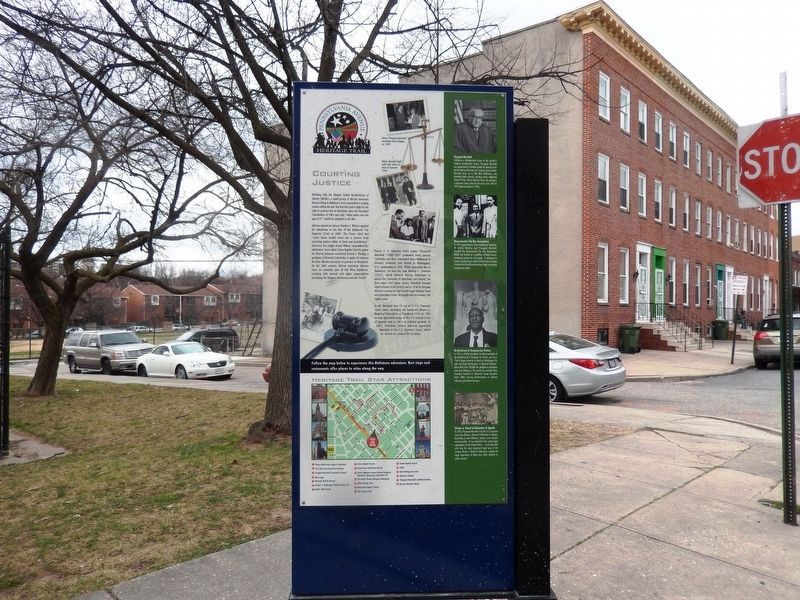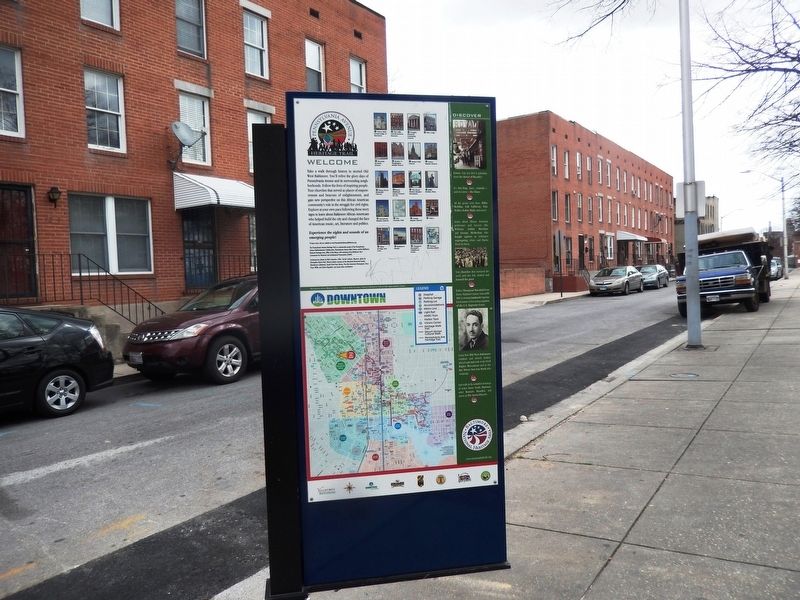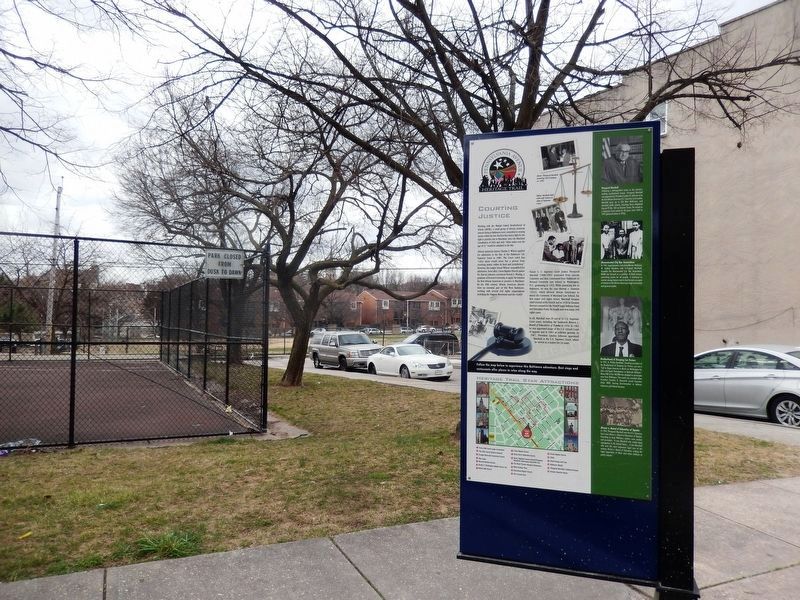Upton in Baltimore, Maryland — The American Northeast (Mid-Atlantic)
Courting Justice
Pennsylvania Avenue Heritage Trail
Working with the Mutual United Brotherhood of Liberty (MUBL), a small group of African American lawyers living in Baltimore were committed to erasing racism within the law. But first they had to fight for the right to practice law in Maryland, since the Maryland Constitution of 1864 said only “white males over the age of 21” would be admitted to the Bar.
African American lawyer Charles S. Wilson applied for admission to the Bar of the Baltimore City Superior Court in 1885. The Court ruled that “color alone would never bar a person receiving justice within its limit and jurisdiction.” However, the judges found Wilson unqualified for admission. Soon after, Union Baptist Church pastor Dr. Harvey Johnson convinced Everett J. Waring, a graduate of Howard University, to apply. He became the first African American to practice in Maryland. By the 20th century, African American lawyers were an essential part of Old West Baltimore, working with several civil rights organizations including the Niagara Movement and the NAACP.
Future U.S. Supreme Court Justice Thurgood Marshall (1908-1993) graduated from Lincoln University and then commuted from Baltimore to Howard University Law School in Washington D.C., graduating in 1933. While practicing law in Baltimore, he won the case Murray vs. Pearson (1935), which allowed African Americans to attend the University of Maryland Law School, his first major civil rights victory. Marshall became chief counsel of the NAACP, and in 1938 he became director of counsel for the NAACP Legal Defense Fund and Education Fund. He fought and won many civil rights cases.
In all, Marshall won 29 out of 32 U.S. Supreme Court cases, including the landmark Brown vs. Board of Education of Topeka in 1954. In 1961 he was appointed judge of the U.S. Circuit Court of Appeals and in 1965 as solicitor general. In 1967, President Lyndon Johnson appointed Marshall to the U.S. Supreme Court, where he served as a justice for 24 years.
(Inscription below the images on the right)
Thurgood Marshall
Following a distinguished career as the country’s leading constitutional lawyer, Thurgood Marshall was appointed by President Lyndon B. Johnson to be the first African American U.S. Supreme Court Justice. Marshall grew up in Old West Baltimore, and attended public schools, including Henry Highland Garnet PS No. 103 on Division Street. He served as a Supreme Court justice for 24 years, from 1967 to 1991 (pictured above in 1976).
Monumental City Bar Association
In 1935, legal pioneers, including Warner McQuinn, W. Ashbie Hawkins and Thurgood Marshall, founded the Monumental City Bar Association. MCBA was formed as a coalition of black lawyers promoting justice for all people. It continues to mentor young lawyers and to host forums on topics of interest to the African American legal community and general public.
Brotherhood of Sleeping Car Porters
In 1941, A. Philip Randolph, founding president of the Brotherhood of Sleeping Car Porters, put out a “Call to Negro America to March on Washington for Jobs and Equal Participation in National Defense.” About 500 of the 100,000 who pledged to participate were from Baltimore. The march was canceled when President Franklin D. Roosevelt issued Executive Order 8802, barring discrimination in defense industries and federal bureaus.
Brown v. Board of Education of Topeka
In 1951, Thurgood Marshall won the U.S. Supreme Court case Brown v. Board of Education of Topeka. According to Juan Williams, author, news analyst and journalist, “It was Marshall who ended legal segregation in the United States…It was Marshall who won the most important legal case of the century, Brown v. Board of Education, ending the legal separation of black and white children in public schools.”
Reverse Side of the Marker
Welcome
Take a walk through history in storied Old West Baltimore. You’ll relive the glory days of Pennsylvania Avenue and its surrounding neighborhoods. Follow the lives of
inspiring people. Tour churches that served as places of empowerment and beacons of enlightenment, and gain new perspective on this African American community’s role in the struggle for civil rights. Explore at your own pace following these story signs to learn about Baltimore African Americans who helped build a city and changed the face of American music, art, literature and politics.
(Inscriptions under the images on the right)
1.Prince Hall Grand Lodge of Maryland
2.The Lillie Carroll Jackson Museum
3.Douglas Memorial Community Church
4.Elks Lodge
5.Morriah Keyhole Houses
6.Booker T. Washington Middle School
7.Bethel AME Church
8.Union Baptist Church
9.Sharp Street Methodist Church
10.Henry Highland Garnet School/PS 103
11.The Royal Theatre Marquee Monument
12.Billie Holiday Plaza
13.Macedonia Baptist Church
14.The Comedy Club
15.Trinity Baptist Church
16.YMCA
17.Ideal Savings and Loan
18.Baltimore Masjid
19.Thurgood Marshall’s Childhood Home
20.Romare Bearden Mural.
Discover
(Inscriptions under the images)
*Listen, Can you feel it pulsating down the Street of Royalty?
*It’s bee-bop, jazz, comedy—and of course—the blues.
*All the greats were here. Billie Holiday, Cab Calloway, Fats Waller, Eubie Blake and more!
*Learn about African American politicians and lawyers like William Ashbie Hawkins and George McMechan who fought against an ordinance segregating whites and blacks block by block.
*Visit churches that nurtured the soul, and also fed, clothed and housed the poor.
*Follow Thurgood Marshall from Henry Highland Garnet School/PS 103, to winning landmark Supreme Court cases, to becoming a justice of the U.S. Supreme Court.
*Learn how Old West Baltimore residents and church leaders played a pivotal role in the Civil Rights Movement and in the Buy Where You Can Work jobs campaign.
*And walk in the creative footsteps of writer Zora Neale Hurston, artist Romare Bearden and actors at the Arena Players.
Topics and series. This historical marker is listed in these topic lists: African Americans • Civil Rights • Government & Politics. In addition, it is included in the Former U.S. Presidents: #36 Lyndon B. Johnson, and the Historically Black Colleges and Universities series lists. A significant historical year for this entry is 1864.
Location. 39° 18.063′ N, 76° 37.769′ W. Marker is in Baltimore, Maryland. It is in Upton. Marker is at the intersection of Division Street and West Lanvale Street on Division Street. The marker is located near the Robert C. Marshall Park. Touch for map. Marker is in this post office area: Baltimore MD 21217, United States of America. Touch for directions.
Other nearby markers. At least 8 other markers are within walking distance of this marker. Henry Highland Garnett School (within shouting distance of this marker); Sharp Street Memorial Church (about 400 feet away, measured in a direct line); Foundation on Which to Build a Community (about 400 feet away); Bethel A.M.E. Church (about 400 feet away); African American Politicians (about 400 feet away); Union Baptist Church (about 500 feet away); The Street of Royalty (about 600 feet away); Henry Highland Garnet Park (about 600 feet away). Touch for a list and map of all markers in Baltimore.
Also see . . . Thurgood Marshall - Find A Grave. (Submitted on March 3, 2017, by Don Morfe of Baltimore, Maryland.)
Credits. This page was last revised on March 16, 2021. It was originally submitted on March 3, 2017, by Don Morfe of Baltimore, Maryland. This page has been viewed 516 times since then and 25 times this year. Last updated on March 16, 2021, by Carl Gordon Moore Jr. of North East, Maryland. Photos: 1, 2, 3. submitted on March 3, 2017, by Don Morfe of Baltimore, Maryland. • Bill Pfingsten was the editor who published this page.


